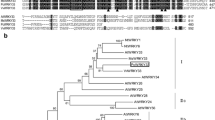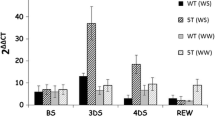Abstract
A novel member of the WRKY gene family, designated TcWRKY53, was isolated from a cadmium (Cd)-treated Thlaspi caerulescens cDNA library by differential screening. WRKY proteins specifically bind to W-boxes, which are found in the promoters of many genes involved in defense and response to environmental stress. TcWRKY53 contains a 975-bp open reading frame encoding a putative protein of 324 amino acids. Homology searches showed that TcWRKY53 resembles similar WRKY domain-containing proteins from rice, parsley and tobacco, especially AtWRKY53 from Arabidopsis thaliana. Semi-quantitative RT-PCR showed that the expression of TcWRKY53 was strongly induced by various environmental stresses, including an excess of NaCl, drought, cold and the signal molecule salicylic acid (SA). The expression of TcWRKY53 in response to NaCl, drought and cold suggested a possible role of TcWRKY53 in abiotic stress response. However, physiological tests indicated that the expression of TcWRKY53 in tobaccos decreases tolerance to sorbitol during seedling root development. This was consistent with PEG6000 treatment of tobacco seedlings, and together these results indicate a negative modulation of TcWRKY53 in response to osmotic stress. Furthermore, two ethylene responsive factor (ERF) family genes, NtERF5 and NtEREBP-1, were negatively induced in TcWRKY53-overexpressing transgenic plants. In contrast, a LEA family gene, NtLEA5, showed no change, suggesting that TcWRKY53 might regulate the plant osmotic stress response by interacting with an ERF-type transcription factor rather than by regulating function genes directly.






Similar content being viewed by others
Abbreviations
- ERF:
-
Ethylene responsive factor
- LEA:
-
Late embryogenesis abundant
- SA:
-
Salicylic acid
References
Asai T, Tena G, Plotnikova J, Willmann MR (2002) MAP kinase signalling cascade in Arabidopsis innate immunity. Nature 415:977–983
Baker AJM, Brooks RR (1989) Terrestrial higher plants, which hyperaccumulate metallic elements–a review of their distribution, ecology and phytochemistry. Biorecovery 1:81–126
Bray EA (1997) Plant responses to water deficit. Trends Plant Sci 2:48–54
Chakravarthy S, Tuori RP, D’Ascenzo MD, Fobert PR, Despres C, Martin GB (2003) The tomato transcription factor Pti4 regulates defense-related gene expression via GCC box and non-GCC box cis elements. Plant Cell 15:3033–3050
Church GM, Gilbert W (1984) Genomic sequencing. Proc Natl Acad Sci USA 81:1991–1995
Close TJ (1997) Dehydrins: a commonality in the response of plants to dehydration and low temperature. Physiol Plant 100:291–296
Dellagi A, Helibronn J, Avrova AO, Montesano M, Palva ET, Stewart HE (2000) A potato gene encoding a WRKY-like transcription factor is induced in interactions with Erwinia carotovora subsp. atroseptica and Phytophthora infestans and is coregulated with class I endochitinase expression. Mol Plant Microbe Interact 13:1092–1101
Dempsey D, Shah J, Klessig DF (1999) Salicylic acid and disease resistance in plants. Crit Rev Plant Sci 18:547–575
Dong J, Chen C, Chen Z (2003) Expression profiles of the Arabidopsis WRKY gene superfamily during plant defense response. Plant Mol Biol 51:21–37
Du L, Chen Z (2000) Identification of genes encoding receptor-like protein kinases as possible targets of pathogenand salicylic acid-induced WRKY DNA-binding proteins in Arabidopsis. Plant J 24(6):837–847
Eulgem T, Rushton PJ, Schmelzer E (1999) Early nuclear events in plant defense: rapid gene activation by WRKY transcription factors. EMBO J 18:4689–4699
Eulgem T, Rushton PJ, Robatzek S, Somssich IE (2000) The WRKY superfamily of plant transcription factors. Trends Plant Sci 5:199–206
Glazebrook J (2001) Genes controlling expression of defense responses in Arabidopsis. Curr Opin Plant Biol 4:301–308
Guo ZJ, Chen XJ, Wu XL, Ling JQ, Xu P (2004) Overexpression of the AP2/EREBP transcription factor OPBP1 enhances disease resistance and salt tolerance in tobacco. Plant Mol Biol 55:607–618
Hara K, Yagi M, Kusano T, Sano H (2000) Rapid systemic accumulation of transcripts encoding a tobacco WRKY transcription factor upon wounding. Mol Gen Genet 263:30–37
Hobo T, Kowyama Y, Hattori T (1999) A bZIP factor, TRAB1, interacts with VP1 and mediates abscisic acid-induced transcription. Proc Natl Acad Sci USA 96:15348–15353
Huang T, Duman JG (2002) Cloning and characterization of a thermal hysteresis (antifreeze) protein with DNA binding activity from winter bittersweet night shade, Solanum dulcamara. Plant Mol Biol 48:339–350
Ingram J, Bartels D (1996) The molecular basis of dehydration tolerance in plants. Annu Rev Plant Physiol Plant Mol Biol 47:377–403
Johnson CS, Kolevski B, Smyth DR (2002) TRANSPARENT TESTA GLABRA2, a trichome and seed coat development gene of Arabidopsis, encodes a WRKY transcription factor. Plant Cell 14:1359–1375
Kalde M, Barth M, Somssich IE, Lippok B (2003) Members of the Arabidopsis WRKY group III transcription factors are part of different plant defense signaling pathways. Mol Plant Microbe Interact 16:295–305
Kang JY, Choi HI, Im MY, Kim SY (2002) Arabidopsis basic leucine zipper proteins that mediate stress-responsive abscisic acid signaling. Plant Cell 14:343–357
Kim K-C, Fan B, Chen Z (2006) Pathogen-induced Arabidopsis WRKY7 is a transcriptional repressor and enhances plant susceptibility to Pseudomonas syringae. Plant Physiol 142:1180–1192
Kizis D, Lumbreras V, Pages M (2001) Role of AP2/EREBP transcription factors in gene regulation during abiotic stress. FEBS Lett 498:187–189
Knoth C, Ringler J, Dangl JL, Eulgem T (2007) Arabidopsis WRKY70 is required for full RPP4-mediated disease resistance and basal defense against Hyaloperonospora parasitica. Mol Plant Microbe Interact 20:120–128
Lagace M, Matton DP (2004) Characterization of a WRKY transcription factor expressed in late torpedostage embryos of Solanum chacoense. Planta 219:185–189
Liu XQ, Bai XQ, Wang XJ, Chu CC (2006) OsWRKY71, a rice transcription factor, is involved in rice defense response. J Plant Physiol doi:10.1016/j.jplph.2006.07.006
Mare C, Mazzueotelli E, Crosatti C (2004) Hv-WRKY38: a new transcription factor involved in cold- and drought-response in barley. Plant Mol Biol 55:399–416
Miao Y, Laun T, Zimmermann P, Zentgraf U (2004) Targets of the WRKY53 transcription factor and its role during leaf senescence in Arabidopsis. Plant Mol Biol 55:853–867
Niu X, Helentjaris T, Bate NJ (2002) Maize ABI4 binds coupling element1 in abscisic acid and sugar response genes. Plant Cell 14:2565–2575
Nylander M, Svensson J, Palva ET, Welin BV (2001) Stress induced accumulation and tissue-specific localization of dehydrins in Arabidopsis thaliana. Plant Mol Biol 45:63–79
Oh SK, Yi SY, Yu SH, Jae SM, Moon JS, Park JM, Choi D (2006) CaWRKY2, a chili pepper transcription factor, is rapidly induced by incompatible plant pathogens. Mol Cells 22:58–64
Park JM, Park CJ, Lee SB, Ham BK, Shin R, Paek KH (2001) Overexpression of the tobacco Tsi1 gene encoding an EREBP/AP2–type transcription factor enhances resistance against pathogen attack and osmotic stress in tobacco. Plant Cell 13:1035–1046
Reiter RS, Young RM, Scolnik PA (1992) Genetic linkage of the Arabidopsis genome: methods for map** with recombinant inbreds and random amplified polymorphic DNAs (RAPDs). In: Konc C, Chua NH, Schell J (eds) Methods in Arabidopsis research. World Scientific, Singapore, pp 170–190
Robatzek S, Somssich IE (2002) Targets of AtWRKY6 regulation during plant senescence and pathogen defense. Genes Dev 16:1139–1149
Rushton PJ, Macdonald H, Huttly AK, Lazarus CM, Hooley R (1995) Members of a new family of DNA-binding proteins bind to a conserved cis-element in the promoters of alpha-Amy2 genes. Plant Mol Biol 29:691–702
Seki M, Narusaka M, Ishida J, Nanjo T (2002) Monitoring the expression profiles of 7000 Arabidopsis genes under drought, cold and high-salinity stresses using a full-length cDNA microarray. Plant J 31(3):279–292
Sun C, Palmqvist S, Olsson H, Boren M, Ahlandsberg S (2003) A novel WRKY transcription factor, SUSIBA2, participates in sugar signaling in barley by binding to the sugar-responsive elements of the iso1 promoter. Plant Cell 15:2076–2092
Turck F, Zhou A, Somssich IE (2004) Stimulus-dependent, promoterspecific binding of transcription factor WRKY1 to its native promoter and the defense-related gene PcPR1-1 in parsley. Plant Cell 16:2573–2585
Wang D, Amornsiripanitch N, Dong X (2006) A genomic approach to identify regulatory nodes in the transcriptional network of systemic acquired resistance in plants. PLoS Pathogens doi:10.1371/journal.ppat.0020123
Wu KL, Guo ZJ, Wang HH (2005) The WRKY family of transcription factors in rice and Arabidopsis and their origins. DNA Res 12(1):9–26
Yoda H, Ogawa M, Yamaguchi Y, Koizumi N, Kusano T, Sanop H (2002) Identification of early-responsive genes associated with the hypersensitive response to tobacco mosaic virus and characterization of a WRKY-type transcription factor in tobacco plants. Mol Genet Genomics 267:154–161
Yuan QJ, Michael KD (2006) Comprehensive transcriptional profiling of NaCl-stressed Arabidopsis roots reveals novel classes of responsive genes. BMC Plant Biol doi:10.1186/1471-2229-6-25
Zhang JZ (2003) Overexpression analysis of plant transcription factors. Curr Opin Plant Biol 6:430–440
Zhang X, Zhang Z, Chen J, Chen Q, Wang XC, Huang R (2005) Expressing TERF1 in tobacco enhances drought tolerance and abscisic acid sensitivity during seedling development. Planta 222:494–501
Zhu JK (2001) Cell signal under salt, water and cold stresses. Curr Opin Plant Biol 4:401–406
Acknowledgments
Seeds of T. caerulescens were kindly donated by Dr. Henk Schat (Institute of Ecological Sciences, The Netherlands) and Mark Aarts (M G Aarts) (Wageningen University, The Netherlands). This research was supported by the National High Technology Planning Program of China (Grant nos. 2006AA10Z407, 2006AA100205 and 2007AA021404) and the China National Natural Sciences Foundation (Grant nos. 39870078 and 30570146).
Author information
Authors and Affiliations
Corresponding author
Additional information
Communicated by A. Feher.
Rights and permissions
About this article
Cite this article
Wei, W., Zhang, Y., Han, L. et al. A novel WRKY transcriptional factor from Thlaspi caerulescens negatively regulates the osmotic stress tolerance of transgenic tobacco. Plant Cell Rep 27, 795–803 (2008). https://doi.org/10.1007/s00299-007-0499-0
Received:
Revised:
Accepted:
Published:
Issue Date:
DOI: https://doi.org/10.1007/s00299-007-0499-0




